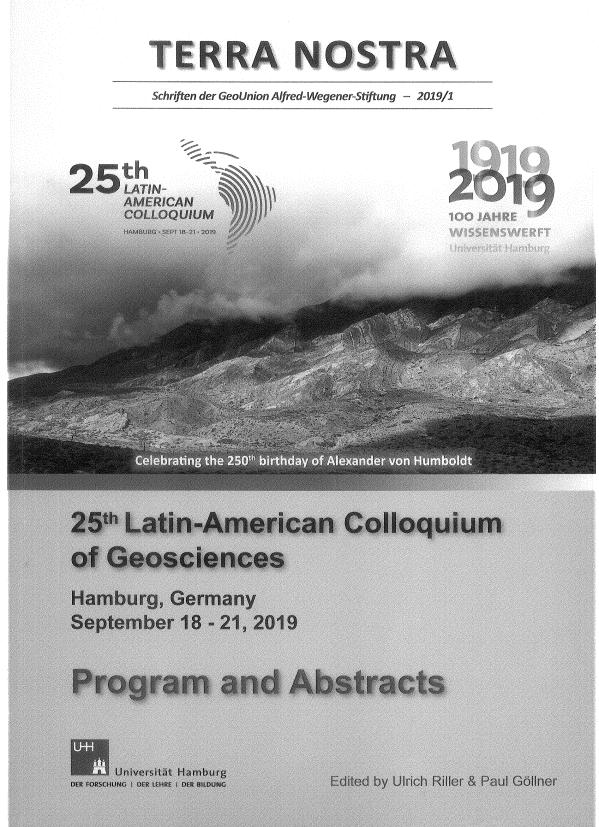Evento
The Quaternary Payún Matrú caldera, andean back-arc of the Southern Volcanic Zone: insights into its caldera-forming eruption deposits
Hernando, Irene Raquel ; Petrinovic, Ivan Alejandro
; Petrinovic, Ivan Alejandro ; Gutiérrez, Damián; Bucher, Joaquin
; Gutiérrez, Damián; Bucher, Joaquin ; Fuentes, Tomás Gregorio
; Fuentes, Tomás Gregorio ; Aragon, Eugenio
; Aragon, Eugenio
 ; Petrinovic, Ivan Alejandro
; Petrinovic, Ivan Alejandro ; Gutiérrez, Damián; Bucher, Joaquin
; Gutiérrez, Damián; Bucher, Joaquin ; Fuentes, Tomás Gregorio
; Fuentes, Tomás Gregorio ; Aragon, Eugenio
; Aragon, Eugenio
Colaboradores:
Riller, Ulrich; Göllner, Paul
Tipo del evento:
Otro
Nombre del evento:
25th Latin American Colloquium
Fecha del evento:
18/09/2019
Institución Organizadora:
University of Hamburg;
Título del Libro:
Libro de Resúmenes del 25 LAC
Título de la revista:
Terra Nostra
Editorial:
Schriften GeoUnion Alfred Wegener-Stiftung
ISSN:
0946-8978
Idioma:
Inglés
Clasificación temática:
Resumen
The Quaternary Payún Matrú caldera is located in the back-arc of the Southern Volcanic Zone of the Andes, western Argentina, and represents the main volcanic edifice of the Payún Matrú Volcanic Field (PMVF). The PMVF is located within Payenia, a volcanic province characterized by alkalic basaltic volcanism. The PMVF presents the homonym caldera along with the Payún Liso volcano and 220 basaltic monogenetic cones. Payún Matrú has a long-lived pre-caldera stage where a shield-like edifice has been built. The syn-caldera stage is represented by the Pleistocene Portezuelo Ignimbrite and the resulting caldera depression of 8.5 km in diameter. Afterwards the caldera event, volcanism continued mostly along the caldera rim.We present stratigraphic sections, facies analysis and mineralogical studies of the Portezuelo Ignimbrite, in order to determine pre-eruptive conditions, onset of collapse and eruptive history of the caldera-forming eruption deposits. The extra-caldera Portezuelo Ignimbrite shows different facies, being most of them massive or eutaxitic and massive lapilli tuff facies, deposited by dense pyroclastic density currents. Fall deposits are found only restrained to the caldera margin, suggesting the lack of a sustained eruptive column at the onset of eruption. Massive tuff facies are found at the topmost deposits south of the caldera, and indicates the development of a co-ignimbritic plume as the pyroclastic density currents wanned. Four distinct juvenile clasts were recognized on the basis of color, shape, size, vesicularity and crystallinity. These are: gray fiamme, light gray pumice, dark gray pumice and black juveniles. Whole-rock chemical analyses of gray fiamme and black juveniles have a similar trachytic composition, while the mineralogical composition of juvenile clasts reveals some differences, specially in feldspars. On the basis of discontinuity surfaces and the juvenile clasts population of the ignimbrite, several eruptive units were defined. Given the absence of lithic breccias, the onset of collapse is suggested by a change in the juvenile clasts population in the topmost eruptive unit, which presents dark gray and light gray pumice together with black juveniles. The sequential appearance of different juvenile clasts suggests a zoned magma chamber, in terms of crystal content and mineralogical composition.
Palabras clave:
Volcanism
,
Caldera
,
Payún Matrú
Archivos asociados
Licencia
Identificadores
Colecciones
Eventos(CIG)
Eventos de CENTRO DE INVEST.GEOLOGICAS (I)
Eventos de CENTRO DE INVEST.GEOLOGICAS (I)
Citación
The Quaternary Payún Matrú caldera, andean back-arc of the Southern Volcanic Zone: insights into its caldera-forming eruption deposits; 25th Latin American Colloquium; Hamburgo; Alemania; 2019; 50-51
Compartir
Altmétricas



